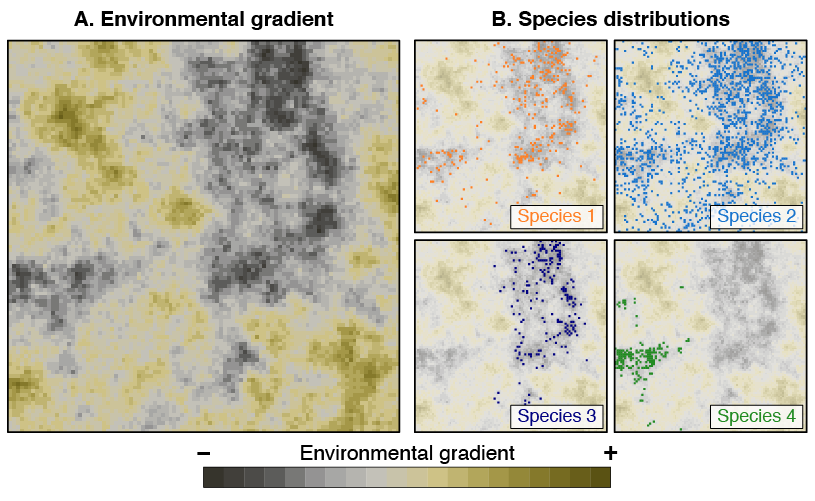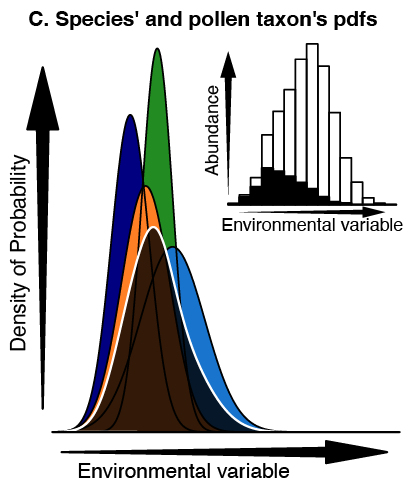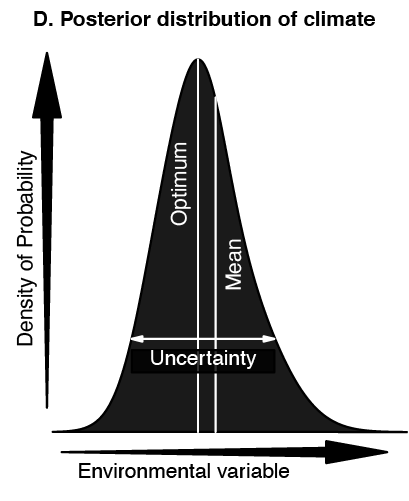The CREST method (Climate REconstruction SofTware) is a climate
reconstruction technique that combines presence-only occurrence data
with modern climatologies to estimate the conditional responses of a
given set of taxa to a variable of interest [1-2]. The
combination of these responses is used to estimate past climate
probabilities. To illustrate the conceptual background of CREST, we will
consider fossil pollen data, as these are great, ubiquitous climate
proxies. One specific characteristic of pollen data is their limited
taxonomical resolution. Usually, pollen cannot be identified at the
species level but at a higher level (sub-genus to family level), which
complexifies the modelling of the pollen-climate responses [3].
Defined as probability density functions (PDFs), these taxon-climate
responses are estimated in one or two steps based on the nature of the
proxy being studied. In simple cases, where fossils can be identified at
the species level (e.g. foraminifers, plant macrofossils), the
PDFs are defined by unimodal and parametric functions (e.g.
normal or log-normal distributions depending on the nature of the
studied variable, see [1-2] for a more detailed discussion). The
parameters (e.g. a mean and a standard deviation in the case of
a normal or log-normal distribution) describing these distributions are
estimated from the ensemble of climate values corresponding to the
presence records (Fig. 1), each being weighted as an
inverse function of its abundance in the study area. This correction
removes the influence of the heterogeneously distributed modern climate
space and ensures that the optimum exhibited by the PDF reflects the
true climatic preference of the species, rather than the modern
abundance of a given climate value [4-5].
Two steps are necessary to create the taxon-climate probabilistic
link when the fossils cannot be identified at the species level
(e.g. pollen grains identified at the genus or family level).
First, following the process above, a parametric PDF is created for each
of the species producing the same type of pollen grains, and then, these
PDFs are grouped together to create a higher-order PDF representing the
pollen type, with each species being weighted as a function of the
extent of its distribution (Fig. 2). One assumption of
the model is that species with larger distributions are considered more
likely to have produced the pollen grain observed in the absence of
independent evidence. No additional assumptions are made concerning the
shapes of these pollen PDFs, thus allowing them to be multimodal if
different species/groupings exhibit different climate requirements. It
is worth noting that the process can be used with incomplete
distribution data because CREST uses parametric functions to define the
species PDFs. Reconstructions from modern [1] and fossil [6-9] data suggest that robust PDFs can still be
obtained from truncated geographical distributions, provided that the
full range of the climatic tolerance of the species is well covered in
the climate space [10].
Finally, the PDFs for each fossil taxon identified in a sample are
multiplied together, each with a weight derived from the observed
percentages. Since relative abundances, different production rates and
taphonomy are important factors influencing the fossil assemblage
observed, direct percentages cannot be used directly, and they need to
be transformed to minimise the effect of these factors. In CREST, the
transformation is performed on a taxon basis by normalising the raw
percentages by the average of the percentages of all the samples where
the taxon is observed (i.e. the zeros are excluded). A value
higher (lower) than one suggests that the climate at the time of
deposition was more (less) favourable (i.e. closer to the
taxon’s climate optimum) than the average climate in which the taxon has
been observed during the studied period. The multiplication of PDFs
results in a likelihood distribution along the climate gradient, from
which climate estimates and uncertainties can be derived (Fig.
3). More technical details about the different
parameterisations of the method can be obtained from the original
publications (1-2).
Compared to other existing climate reconstruction methods, the
probabilistic nature of CREST also provides a unique opportunity to
derive probabilistic reconstructions. Such likelihood distributions
describe the likelihood of all the climate values along a studied
climate gradient and not just a single ‘best estimate’ associated with a
standard error [10]. The spread of these
uncertainties represents the amount of information available for the
studied system: well-constrained samples generally have relatively
narrower uncertainty ranges than samples with fewer constraints. This
advantage can ultimately be used in data-data comparisons and to
assimilate CREST-based reconstructions with Earth System Models
palaeo-simulations.
References
[1] Chevalier, M.,
Cheddadi, R., Chase, B.M., 2014. CREST (Climate REconstruction
SofTware): a probability density function (PDF)-based quantitative
climate reconstruction method. Clim. Past 10, 2081–2098. doi:10.5194/cp-10-2081-2014.
[2] Chevalier, M., 2022.
crestr an R package to perform probabilistic climate
reconstructions from palaeoecological datasets. Clim. Past doi:10.5194/cp-18-821-2022.
[3] Chevalier, M., 2019.
Enabling possibilities to quantify past climate from fossil assemblages
at a global scale. Global and Planetary Change, 175, pp. 27–35. doi:10.1016/j.earscirev.2020.103384.
[4] Kühl, N., Gebhardt, C.,
Litt, T., Hense, A., 2002. Probability Density Functions as
Botanical-Climatological Transfer Functions for Climate Reconstruction.
Quat. Res. 58, 381–392. doi:10.1006/qres.2002.2380.
[5] Bray, P.J., Blockley,
S.P.E., Coope, G.R., Dadswell, L.F., Elias, S.A., Lowe, J.J., Pollard,
A.M., 2006. Refining mutual climatic range (MCR) quantitative estimates
of palaeotemperature using ubiquity analysis. Quat. Sci. Rev. 25,
1865–1876. doi:10.1016/j.quascirev.2006.01.023.
[6] Chevalier, M., Chase, B.M.,
2015. Southeast African records reveal a coherent shift from high- to
low-latitude forcing mechanisms along the east African margin across
last glacial–interglacial transition. Quat. Sci. Rev. 125, 117–130. doi:10.1016/j.quascirev.2015.07.009.
[7] Chevalier, M., Chase, B.M.,
2016. Determining the drivers of long-term aridity variability: a
southern African case study. J. Quat. Sci. 31, 143–151. doi:10.1002/jqs.2850.
[8] Lim, S., Chase, B.M.,
Chevalier, M., Reimer, P.J., 2016. 50,000 years of climate in the Namib
Desert, Pella, South Africa. Palaeogeogr. Palaeoclimatol. Palaeoecol.
451, 197–209. doi:10.1016/j.palaeo.2016.03.001.
[9] Cordova, C.E., Scott,
L., Chase, B.M., Chevalier, M., 2017. Late Pleistocene-Holocene
vegetation and climate change in the Middle Kalahari, Lake Ngami,
Botswana. Quat. Sci. Rev. 171, 199–215. doi:10.1016/j.quascirev.2017.06.036.
[10] Chevalier, M.,
Davis, B.A.S., Heiri, O., Seppä, H., Chase, B.M., Gajewski, K.,
Lacourse, T., Telford, R.J., Finsinger, W., Guiot, J., Kühl, N.,
Maezumi, S.Y., Tipton, J.R., Carter, V.A., Brussel, T., Phelps, L.N.,
Dawson, A., Zanon, M., Vallé, F., Nolan, C., Mauri, A., de Vernal, A.,
Izumi, K., Holmström, L., Marsicek, J., Goring, S., Sommer, P.S.,
Chaput, M. and Kupriyanov, D., 2020. Pollen-based climate reconstruction
techniques for late Quaternary studies. Earth-Science Reviews, 210,
pp. 103384. doi:10.1016/j.earscirev.2020.103384.


